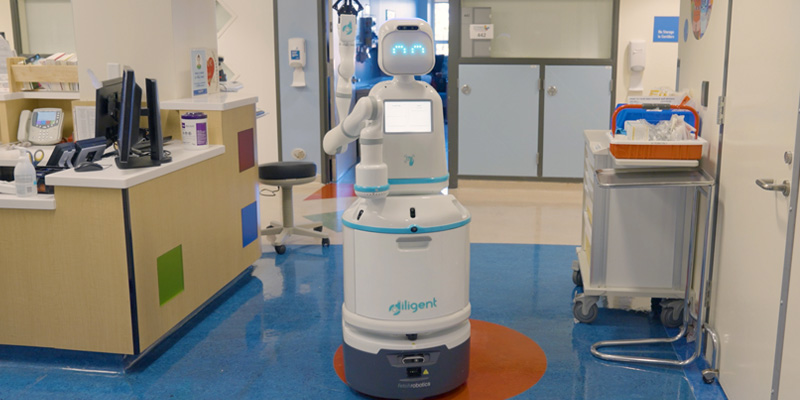It has only been a few months since chief transformation and digital officer Omkar Kulkarni onboarded a new robot. Moxi assists the pharmacy technicians at Children’s Hospital Los Angeles (CHLA) with some of their day-to-day functions, and everyone on the team is already impressed.
“Moxi has been tremendously helpful,” says Christopher Li, pharmacy supervisor at CHLA. “Nurses and medical assistants can now focus on patient care and higher-level tasks.”

The benefits of health care robots
CHLA’s robotic journey began in 2019 when Kulkarni’s team reached across the organization seeking to identify operational pain points for its employees. The hospital’s pharmacy director pointed out the inefficiencies of having pharmacy technicians walking medications across CHLA’s campus and proposed using a specially designed health care robot assistant for this task.
Enter Moxi, a 4-foot-tall, 300-pound robot that travels between CHLA’s pharmacy and patient floors fulfilling medication requests 24 hours a day. In two and a half months, Moxi has made more than 1,400 deliveries, traveled 73 miles and saved staff 900 hours.
Carol Taketomo, PharmD, chief pharmacy officer, says Moxi has relieved foot pain for employees who previously had to deliver medication, enabled service to continue during staff breaks, and made operations more efficient and productive, especially at night when fewer employees are working.
“Moxi’s support in delivering meds helps the staff to recoup 20 to 30 minutes per delivery,” she says. Among other tasks, that extra time allows pharmacy staff to work on new orders, stat doses, compound oral medications, and prepare complex, high-risk medications.
In two and a half months, Moxi has made more than 1,400 deliveries, traveled 73 miles and saved staff 900 hours.
Kulkarni says the hospital’s lease agreement for its two robots amounts to a per-hour cost lower than full-time employees performing the same duties—so CHLA is seeing an immediate return on its financial investment. And that ROI doesn’t take into account the message it sends to the hospital’s staff members.
“This is a great example of how we are ensuring our team members are able to do their best work at the top of their skillset,” Kulkarni says. “Our nursing leaders and pharmacy team are appreciative that we’re investing in this kind of technology.”
The investment is paying off with patients and their families as well, as Moxi rapidly becomes a fixture of CHLA’s culture. “Here’s this giant robot toy that moves and beeps and is kind of a sci-fi thing running around the hospital—it’s bringing joy to these kids,” Kulkarni says.
Future uses of health care robots
CHLA is still in the early stages of understanding Moxi’s capabilities and how best to deploy the robots to further ease staff workload burdens. In assessing the broader pediatric health care landscape, Kulkarni foresees a larger role for robot technology on the horizon.
“We’re always going to have a limited amount of highly qualified, highly skilled people who can provide important clinical care for our patients,” Kulkarni says. “And there’s always going to be a lot of kids who need to be seen and not enough people to take care of them—so whether it’s robots or other forms of automation, we’ve got to figure out ways to leverage technology to bridge the gap.”



